
Centre of Jaina Studies Newsletter: SOAS - University of London
Jaina art was very much in evidence in New York City this autumn with two exhibitions. The Victorious Ones: Jain Images of Perfection at the Rubin Museum of Art from 18 September 2009 to 15 February 2010 presented an historical survey of the Jina in painting and sculpture, comprised of works from private and public collections in the United States and Europe. Peaceful Conquerors: Jain Manuscript Painting at the Metropolitan Museum of Art from 10 September 2009 to 28 March 2010 was themed to illustrated manuscripts, but also included other works, mostly bronzes, from the Museum's permanent collection.
The Rubin Museum of Art
In the Curator's Preface in the catalogue for The Victorious Ones: Jain Images of Perfection, Phyllis Granoff states: "In the exhibition we have tried to create an intimation of the vast scope and power of the Jain vision of its sacred cosmos, a place where the viewer may encounter the Jinas as they have been represented by devotees across the Indian subcontinent throughout history."[1] This intent was realized not only through an impressive array of thirty-five devotional, narrative and cosmographic paintings on paper and cloth, and twenty-nine bronze and stone sculptures, but also through the rendering of the display itself.
Upon entering the exhibition area, which took up the entire top floor of the Museum, one was thunderstruck by the beauty and elegance of the space, with a large, early nineteenth-century Śatruñjaya pilgrimage paṭa from Gujarat dominating the view (Figure 1). The paintings and sculptures, under spotlights, gleamed like gems in the sun, nicely offset by walls in a colour scheme of plum and aubergine. The gallery was divided into thematic areas that facilitated a contemplative atmosphere for viewing the iconography. Leaves (or folios) from manuscripts, including some unusual examples, such as two Kalpasūtra folios with non-formulaic depictions of scenes from the life of Mahāvīra,[2]were displayed together. The section of manuscripts segued to cosmographic paintings and on to pilgrimage paṭas in the centre of the gallery. The devotional paintings, a group of mid-nineteenth-century Digambara works from Karṇāṭaka, were displayed alongside bronze sculptures that were also devotional, an assortment of northern and southern styles that reflected both the Digambara and Śvetāmbara sects. The stone sculptures, spanning the early fifth through thirteenth centuries, were interspersed throughout the gallery.[3]
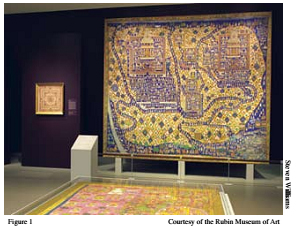
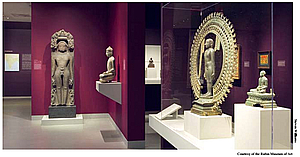
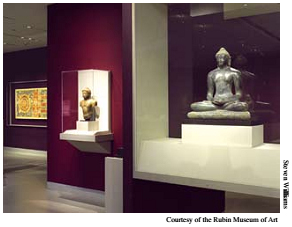
Considered as a whole, the exhibition revealed an historical survey of Jaina art throughout India from the early fifth to the mid-nineteenth centuries. As if in keeping with the role of Jinas as the founding teachers of Jainism, a pedagogical aspect was evident throughout. An introduction to Jainism and Jinas was painted on the wall at the entrance to the gallery, and a complimentary colour pamphlet, with images from the exhibition and translated quotes from Jaina texts, provided further information. Mounted on the wall, a large map of India indicated the main sites of Jaina worship throughout the subcontinent. Still more could be learned from the meticulously detailed labels accompanying each artifact.
A community of academics, collectors and editors had worked for over a year to bring this exhibition to fruition. In a collaboration that crossed the disciplines of the Study of Religions and South Asian Art History, pertinent data had been reassessed, and experts had been able to confer on the dating and classification of works. The findings were recorded in the extensive, lavishly illustrated catalogue, and further discussed at Jain Art and Ritual: From Antiquity to Modernity, a symposium held in conjunction at Yale University (also reported in this issue). Significantly, the exhibition evinced that a whole history of Indian art could be written solely on the basis of Jaina examples, countering a general perception in South Asian Art History that Jaina art is a peripheral strand.
In the decontextualized space of the Rubin Museum of Art these representations of the Jina were extended beyond their original purpose as objects of worship to become catalysts for an interdisciplinary academic exchange and to serve as vehicles for introducing Jainism to an international audience. Overall, the exhibition imparted an atmosphere of the sacred, whilst showcasing the icons as great works of art in their own right.
The Metropolitan Museum of Art
A smaller, concurrent exhibition at the Metropolitan Museum of Art, Peaceful Conquerors: Jain Manuscript Painting, primarily featured illustrated manuscript pages from the Museum's permanent collection. Anyone with an appreciation for illuminated manuscripts would have been impressed by this survey of the medieval Jaina literary arts. A pair of early twelfth-century Jaina manuscript covers depicted figures conjectured to illustrate scenes from the life of a Jina (Figure 2). Several early examples, such as late fourteenth- century Kalpasūtra folios from Gujarat, were displayed together, and leaves from a complete manuscript of a fifteenth-century Kalpasūtra, also from Gujarat, painted in shades of gold and lapis blue, wrapped around the room. This presentation might have been enhanced had the folios been displayed in a consistent narrative sequence, rather than the focus having been on the merits of individual pages. Also of note was a late fifteenth-century deluxe folio from Gujarat with dancers in the margins and the text written in gold against a coloured background (Figure 3).
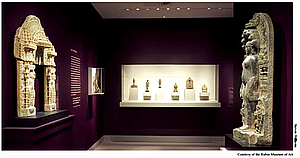

Figure 2 (Above): One of a Pair of Jain Manuscript Covers (Patli) India (Gujarat), early 12th century Opaque watercolor on wood, 5.5 X 32.4 cm The Metropolitan Museum of Art Gift of Guy and Marie-Hélène Weill, 1984 (1984.496.33a) Image © The Metropolitan Museum of Art
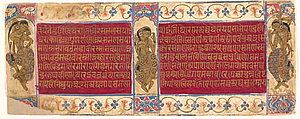
Figure 3 (Below): Celestial Performers: Folio from a Kalpasūtra Manuscript India (Gujarat), ca. 1490 Ink and opaque watercolor on paper, 11.4 X 29.2 cm Metropolitan Museum of Art, Purchase, Gift of Margery and Harry Kahn, 1977 (1977.41) Image © The Metropolitan Museum of Art
A sixteenth to seventeenth-century Gujarati painted textile of celestial musicians watched over the exhibition space, which also included some examples from the Metropolitan Museum's fine collection of Jaina sculpture. Highlights included the earliest example in the Museum's collection, a late sixth to early seventh-century copper alloy sculpture of Bāhubali from Karṇāṭaka, and a late seventh to early eighth-century bronze from Gujarat depicting the Jina Nemi attended by Gomedha and Ambikā.[4]
Lastly, also worthy of mention is that the exhibition called attention to two standing displays of Jaina art from the Museum's permanent collection. To the side of the staircase leading up to the special exhibition, visitors were greeted by a nearly life-sized, early eleventh-century marble sculpture of a Jina in the Śvetāmbara style, seated in meditation on a marble throne cushion. Crowning the staircase itself, the tone for what was to come was set by a teakwood architectural structure, consisting of a dome, ornamental balconies and supports, from an assembly hall (gūḍha-maṇḍapa) of the Vāḍī Pārśvanātha Jaina Temple, which was dedicated on 13 May 1596 in Patan, Gujarat. After having been discarded in the course of renovations in the early twentieth century, the structure was put to new purpose. In the context of the Metropolitan Museum of Art, it stands as a monument to the beauty of Jaina artistic expression.
With the concurrent exhibitions, The Victorious Ones: Jain Images of Perfection at the Rubin Museum of Art and Peaceful Conquerors: Jain Manuscript Painting at the Metropolitan Museum of Art, Jaina art quietly and peacefully claimed its place within the New York art establishment.
Granoff, Phyllis ed. Victorious Ones: Jain Images of Perfection, New York: Rubin Museum of Art and Ahmedabad: Mapin, 2009, p. 13.
For images of these manuscript pages, lent by the Yale University Art Gallery, please see the catalogue Nos. P 11-12, pp. 244-247.
Some of the individual works were discussed and illustrated in the March 2009 issue of Jaina Studies by Robert J. Del Bontà, who along with Sonia Rhie Quintanilla, wrote the catalogue entries for Victorious Ones: Jain Images of Perfection.